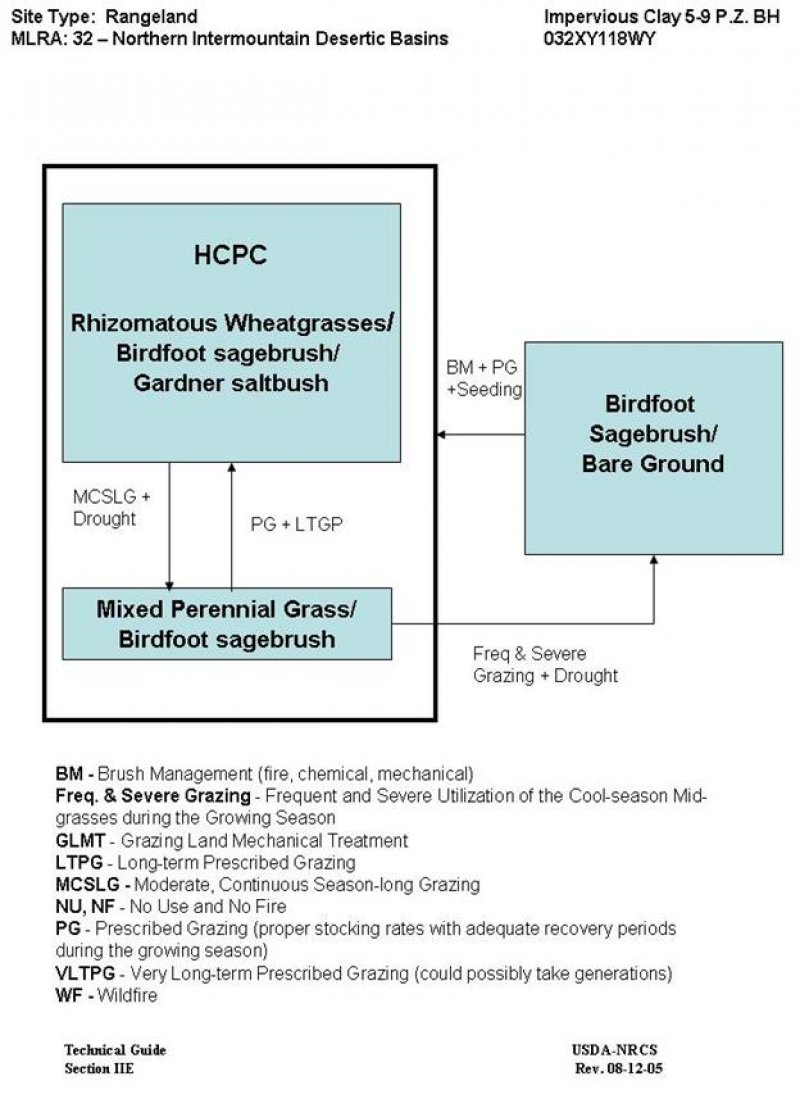
Natural Resources
Conservation Service
Ecological site DX032X01A110
Dense Clay (DC) Big Horn Basin Core
Last updated: 9/05/2019
Accessed: 12/17/2025
General information
Provisional. A provisional ecological site description has undergone quality control and quality assurance review. It contains a working state and transition model and enough information to identify the ecological site.
MLRA notes
Major Land Resource Area (MLRA): 032X–Northern Intermountain Desertic Basins
Major land resource area (MLRA):
032X – Northern Intermountain Desertic Basins – This MLRA is comprised of two major Basins, the Big Horn and Wind River. These two basins are distinctly different and are split by LRU’s to allow individual ESD descriptions. These warm basins are surrounded by uplifts and rimmed by mountains, creating a unique set of plant responses and communities. Unique characteristics of the geology and geomorphology single these two basins out.
Further information regarding MLRAs, refer to: United States Department of Agriculture, Natural Resources Conservation Service. 2006. Land Resource Regions and Major Land Resource Areas of the United States, the Caribbean, and the Pacific Basin. U.S. Department of Agriculture Handbook 296. Available electronically at: http://www.nrcs.usda.gov/wps/portal/nrcs/detail/soils/ref/?cid=nrcs142p2_053624#handbook.
LRU notes
Land Resource Unit (LRU):
32X01A (WY): This LRU is the Big Horn Basin within MLRA 32. This LRU is lower in elevation, slightly warmer and receives slightly less overall precipitaiton than the Wind River Basin (LRU 02). This LRU was originally divided into two LRU's - LRU A which was the core and LRU B which was the rim. With the most current standards, this LRU is divided into two Subsets. This subset is Subset A, referred to as the Core, which is warm, dry eroded basin floor. As the LRU shifts outer edges, aspect and relation to the major bodies of water and taller landforms create minor shifts in soil chemistry influencing the variety of ecological sites and plant interactions. The extent of soils currently correlated to this ecological site does not fit within the digitized boundary. Many of the noted soils are provisional and will be reviewed and corrected in mapping update projects. Other map units are correlated as small inclusions within other MLRA’s/LRU’s based on elevation, landform, and biological references. Older ESD's will refer to LRU A. LRU A and LRU 01 in MLRA 32X are synonymous.
Moisture Regime: Typic Aridic, prior to 2012, there are map units that cross over to ustic aridic or ustic aridic was correlated into this core area. As progressive mapping continues and when the ability to do update projects, these overlapping map units will be corrected.
Temperature Regime: Mesic
Dominant Cover: Rangeland, with Saltbush flats the dominant vegetative cover for this LRU/ESD.
Representative Value (RV) Effective Precipitation: 5-9 inches (127 – 229 mm)
RV Frost-Free Days: 110-150 days
Classification relationships
Relationship to Other Established Classification Systems:
National Vegetation Classification System (NVC):
3 Xeromorphic Woodland, Scrub & Herb Vegetation Class
3.B Cool Semi-Desert Scrub & Grassland Subclass
3.B.1 Cool Semi-Desert Scrub & Grassland formation
3.B.1.NE Western North American Cool Semi-Desert Scrub & Grassland Division
Ecoregions (EPA):
Level I: 10 North American Deserts
Level II: 10.1 Cold Deserts
Level III: 10.1.18 Wyoming Basin
Level IV: 10.1.18.g Big Horn Salt Desert Shrub Basin
Ecological site concept
• Site receives no additional water.
• Slope is <30%
• Soils are:
o Textures range from fine sandy clay loam to clay in top 4” (10 cm) of mineral soil surface
o Clay content is < 35% in top 4” (10 cm) of mineral soil surface
o All subsurface horizons in the particle size control section have a weighted average of ≥ 35% clay. (The particle size control section is the segment of the profile from either the start of an argillic horizon for 50 cm’s or from 25-100 cm’s).
o Moderately deep to very deep (20-80+ in. (50-200+ cm)
o Not skeletal (<35% rock fragments) within 20” (50 cm) of mineral soil surface
o None to Slightly effervescent throughout top 20” (50 cm) of mineral soil surface
o Non-saline, sodic, or saline-sodic
Site drafted from historic range site: R032XY118WY. Based heavy clay soils that develop large cracks at the surface when dry. Site has a thin cap of coarser soils on the surface. This community is dominated by birdfoot sagebrush and generally lacks Wyoming big sagebrush.
Associated sites
| R032XY144WY |
Saline Upland (SU) 5-9” Big Horn Basin Precipitation Zone Saline upland site will occur in close proximity with the dense clay site appearing higher on the landscape with lower affect by salt accumulations. Site is both associated and similar. |
|---|---|
| R032XY104WY |
Clayey (Cy) 5-9” Big Horn Basin Precipitation Zone Dense clay will occur in small swales or side slopes with the clayey site. Site is both associated and similar. |
| R032XY138WY |
Saline Lowland (SL) 5-9” Big Horn Basin Precipitation Zone Site is found in connection to dense clay, with the dense clay occurring on higher nobs above influence of runoff or a water table, and saline lowland occurring on a step below or in small depressions along a drainage system. |
Similar sites
| R032XY344WY |
Saline Upland (SU) 10-14" East Precipitation Zone Saline Upland may be similar in production with a shift in species. Saline Upland is Gardner's saltbush dominated (significant salts - sodic, saline, gypsic, saline-sodic) while Dense Clay is birdfoot sagebrush dominated (minimal to no salt accumulations). |
|---|---|
| R032XY304WY |
Clayey (Cy) 10-14" East Precipitation Zone Site is similar to Dense clay but is lacking the coarser surface textures and supports Wyoming big sagebrush and mixed mid-stature grasses for overall greater production. |
Table 1. Dominant plant species
| Tree |
Not specified |
|---|---|
| Shrub |
(1) Artemisia pedatifida |
| Herbaceous |
(1) Pascopyrum smithii |
Legacy ID
R032XA110WY
Click on box and path labels to scroll to the respective text.
